Year :
2007
Title :
Biology
Exam :
JAMB Exam
Paper 1 | Objectives
41 - 50 of 50 Questions
| # | Question | Ans |
|---|---|---|
| 41. |
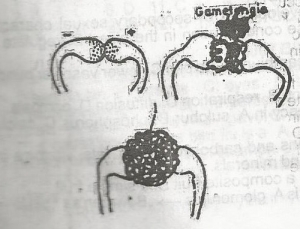 Use the diagram above to answer this question. A. gametogenesis B. sporulation C. sexual reproduction in Spirogyra D. sexual reproduction in Rhizopus |
D |
| 42. |
 Use the diagram above to answer this question. A. sporangium B. hypha C. zygospore D. conidiospore |
C |
| 43. |
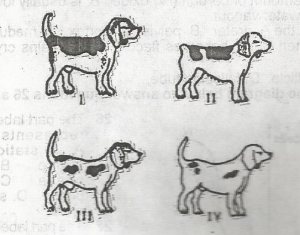 Use the diagram above to answer this question. A. ll B. l C. IV D. lll |
B |
| 44. |
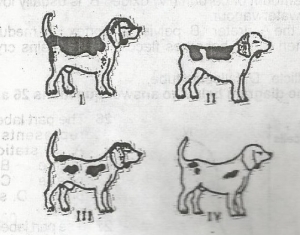 Use the diagram above to answer this question. A. None of its offspring will be born without a tail B. 3/4 of its offspring will be born without tails C. All its offspiring will be born without tails D. 1/4 of its offspring will be born without tails |
A |
| 45. |
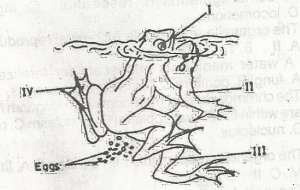 In the diagram, it shows that the orgasms are A. hermaphrodite B. viviparous C. oviparous D. ovoviviparous |
C |
| 46. |
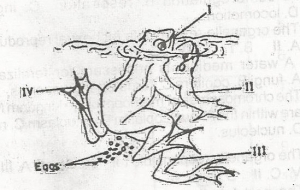 The breeding posture illustrated in the diagram is known as A. mating B. amplexus C. courtship display D. reproductive swimming Detailed SolutionAmplexus defines the mating position of frogs and toads, in which the male clasps the female about the back. |
|
| 47. |
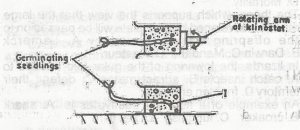 In the diagram, the experiment demonstrates A. geotropism B. thigmotropism C. phototropism D. hydrotropism Detailed SolutionCharles Darwin was one of the first to scientifically document that roots show positive gravitropism and stems show negative gravitropism. That is, roots grow in the direction of gravitational pull (i.e., downward) and stems grow in the opposite direction (i.e., upwards). |
|
| 48. |
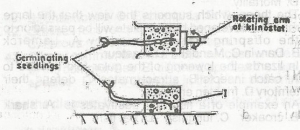 In the diagram, the part marked I will contain a high concentration of A. ascorbic acid B. abscisic acid C. ethylene D. auxin |
D |
| 49. |
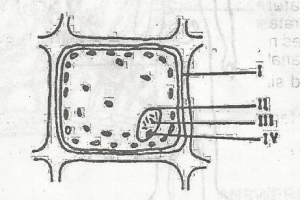 In the diagram, the organelle responsible for heredity is A. iii B. iv C. ii D. i |
A |
| 50. |
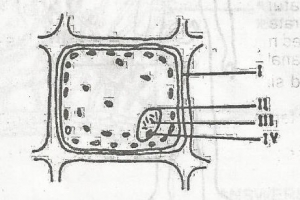 In the diagram, the part labelled I is the A. nuclear membrane B. cell wall C. endoplasmic recticulum D. plasmellema |
B |
| 41. |
 Use the diagram above to answer this question. A. gametogenesis B. sporulation C. sexual reproduction in Spirogyra D. sexual reproduction in Rhizopus |
D |
| 42. |
 Use the diagram above to answer this question. A. sporangium B. hypha C. zygospore D. conidiospore |
C |
| 43. |
 Use the diagram above to answer this question. A. ll B. l C. IV D. lll |
B |
| 44. |
 Use the diagram above to answer this question. A. None of its offspring will be born without a tail B. 3/4 of its offspring will be born without tails C. All its offspiring will be born without tails D. 1/4 of its offspring will be born without tails |
A |
| 45. |
 In the diagram, it shows that the orgasms are A. hermaphrodite B. viviparous C. oviparous D. ovoviviparous |
C |
| 46. |
 The breeding posture illustrated in the diagram is known as A. mating B. amplexus C. courtship display D. reproductive swimming Detailed SolutionAmplexus defines the mating position of frogs and toads, in which the male clasps the female about the back. |
|
| 47. |
 In the diagram, the experiment demonstrates A. geotropism B. thigmotropism C. phototropism D. hydrotropism Detailed SolutionCharles Darwin was one of the first to scientifically document that roots show positive gravitropism and stems show negative gravitropism. That is, roots grow in the direction of gravitational pull (i.e., downward) and stems grow in the opposite direction (i.e., upwards). |
|
| 48. |
 In the diagram, the part marked I will contain a high concentration of A. ascorbic acid B. abscisic acid C. ethylene D. auxin |
D |
| 49. |
 In the diagram, the organelle responsible for heredity is A. iii B. iv C. ii D. i |
A |
| 50. |
 In the diagram, the part labelled I is the A. nuclear membrane B. cell wall C. endoplasmic recticulum D. plasmellema |
B |